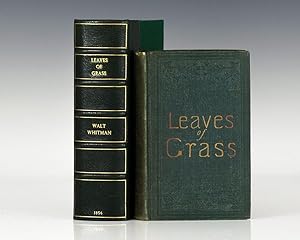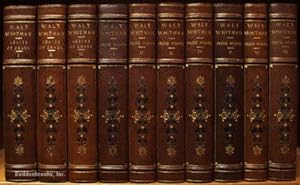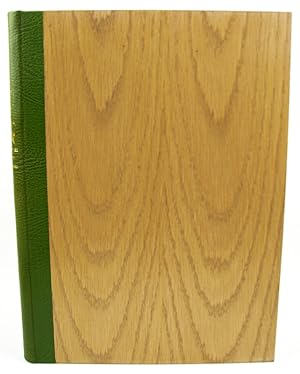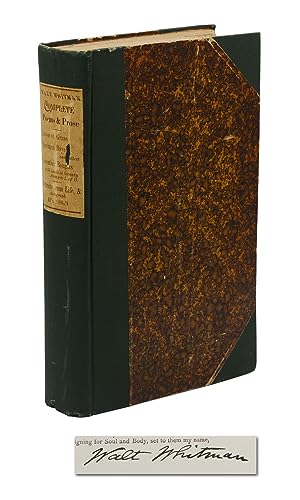Walt Whitman (Over 3,800 results)
Product Type
- All Product Types
- Books (3,815)
- Magazines & Periodicals (18)
- Comics
- Sheet Music (5)
- Art, Prints & Posters
- Photographs (5)
- Maps
-
Manuscripts &
Paper Collectibles (19)
Condition
Binding
Collectible Attributes
- First Edition (556)
- Signed (117)
- Dust Jacket (325)
- Seller-Supplied Images
- Not Printed On Demand (3,184)
Free Shipping
Seller Location
Seller Rating
-
Leaves of Grass
Published by Brooklyn, New York, 1855
Seller: James Cummins Bookseller, ABAA, New York, NY, U.S.A.
First Edition
First edition, first issue. First edition, first issue. Engraved frontispiece portrait of Whitman by Samuel Hollyer after a photograph, printed on thick paper. xii, [13]-95 pp. 1 vols. Small folio (11-1/8 x 7-3/4 in.; 284 x 197 mm). 'I see and hear the whole'. "He was and is the poet and prophet of democracy, and the intoxication of his immense affirmative, the fervor of his 'barbaric yawp,' are so powerful that the echo of his crude yet rhythmic song rings forever in the American air" (Grolier One Hundred). The self-publishedLeaves was at least partially personallytype-set by the author on a small handpress in Brooklyn. The portrait of Whitman is here in superior condition, without the foxing often encountered. This copy bears the printed copyright statement on the verso of the title page and has the first version of line 2 of page 49 ("And the night is for you and me and all") identified by Schmidgall in his article, "1855: a Stop-Press Revision." Of the original 795 copies, only 337 were issued in the first binding with extensive gilt stamping, marbled endsheets, and gilt edges (in the second binding only the title was gilt, and plain yellow endsheets were used). A beautiful copy of a landmark work in American literature. BAL 21395; Grolier American 67; Johnson, High Spots 79; Meyerson A.2.1.a1; PMM 340; Wells & Goldsmith 3; Feinberg/ Detroit 269; Schmidgall, "1855: a Stop-Press Revision," Walt Whitman Quarterly Review 18, Fall/Summer 2000, pp. 74-76 Original green cloth, boards with floral decorations in blind, gilt-lettered ornamental title within a triple-fillet border, spine gilt with title and floral ornaments, marbled endsheets, a.e.g. Title-page very lightly toned, gilt title of upper board a bit dull. Tiniest of repairs to spine (scuffs at center and ends, conserved with no loss). Old description slip tipped to front flyleaf. A fine copy. Half green morocco slipcase, chemise Engraved frontispiece portrait of Whitman by Samuel Hollyer after a photograph, printed on thick paper. xii, [13]-95 pp. 1 vols. Small folio (11-1/8 x 7-3/4 in.; 284 x 197 mm).
-
Leaves of Grass [with] Whitman s own copy of his 1860 portrait
Published by Brooklyn, New York, 1855
Seller: 19th Century Rare Book & Photograph Shop, Stevenson, MD, U.S.A.
Book Signed
Hardcover. Condition: Near Fine. Small folio. Engraved portrait of Whitman (state A, printed on heavy paper). Original gilt decorated green cloth, all edges gilt (binding A), inner hinges expertly repaired. Copyright notice printed in two lines as usual, cities and correctly printed on p. iv. Very minor wear, several leaves neatly repaired at gutter. Morocco case. A very handsome copy. First edition, first issue, one of only 337 copies of the first issue, distinguished by its elaborately gilt-stamped cloth binding prepared in June/July 1855. Whitman reported that only 800 copies were printed; this copy is from the first group to be bound. The copies bound later did not have the extensive gilt stamping. Whitman paid for the book, supervised its production, and even set a number of pages in type. If one attempts to list the artistic achievements of our nation against the background of Western tradition, our accomplishments in music, painting, sculpture, architecture tend to be somewhat dwarfed. The exception is in literature. No western poet, in the past century and a half, not even Browning or Leopardi or Baudelaire, overshadows Walt Whitman or Emily Dickinson. The book that matters most is the original 1855 Leaves of Grass (Harold Bloom, The Western Canon). The 1855 edition [of Leaves of Grass] is brilliantly sui generis and it is the American equivalent of the 1609 sonnets of Shakespeare the single most important volume in its nation s poetic patrimony (Schmidgall). Always the champion of the common man, Whitman is both the poet and the prophet of democracy. The whole of Leaves of Grass is imbued with the spirit of brotherhood and a pride in the democracy of the young American nation (Printing and the Mind of Man). Provenance: a rare example with an 1855 ownership signature, this copy is signed and dated October 1855 by Edmund G. Baker on the verso of the frontispiece. Printing and the Mind of Man 340. Grolier 100 American Books 67. [offered with] Whitman s own signed copy of the famous 1860 portrait WHITMAN, WALT. Signed portrait of Whitman standing, one hand holding his hat, the other in his pocket. 1860, printed in 1889. Photomechanical print on heavy stock, 8 1⁄2 x 6 1⁄4 in. Near fine. Whitman s friend, biographer, and literary executor Horace Traubel pulled this very portrait out the poet s trash. Traubel has written See Notes Mar 3, 91 in the upper right corner. The March 3, 1891 entry in Traubel s With Walt Whitman in Camden states I rescued also from his waste papers a portrait he had marked 1860 usually given about 1850 as date. Whitman sat for the portrait in 1860. He later called it a devilish, tantalizing mystery that he could not date with certainty. Declaring that he would hate to give it up! the poet appreciated its calm don t-care-a-damnativeness its go-to-hell-and-find-outativeness: it has that air strong, yet is not impertinent: defiant: yet it is genial. Provenance: Walt Whitman, rescued from his waste papers by Horace Traubel, as he relates in With Walt Whitman in Camden, March 3, 1891. Signed by Author(s).
-
Leaves of Grass
Published by New York, 1855
Seller: B & L Rootenberg Rare Books, ABAA, Sherman Oaks, CA, U.S.A.
FIRST EDITION, First issue. Half morocco on marbled boards with original front cover bound inside (at the back).
-
Photographic portrait inscribed by Whitman with four lines from Salut au Monde!
Seller: 19th Century Rare Book & Photograph Shop, Stevenson, MD, U.S.A.
Signed
No Binding. Condition: Near Fine. A rare portrait with a Leaves of Grass quotation in Whitman s hand. The photogenic and self-promoting poet sat for (and gave away) many photographs, but very rarely did he inscribe them with his verse. Here he writes lines from his poem Salut au Monde! his calling card to the world, as well as one of his most successful compositions. Whitman writes beneath this portrait the very lines that Folsom and Allen call a prophetic exclamation of Whitman s desire for an international audience (Walt Whitman & the World, p. 1): My spirit has passed in compassion and determination around the whole earth, I have look d for equals & lovers, and found them ready for me in all lands; I think some divine rapport has equalized me with them. Salut au Monde! is Whitman s calling card to the world, as well as one of his most successful compositions. With its closeups and panoramic visions of the earth, the poem extends and internationalizes the outward progression of the first person seer in Song of Myself. It begins the journey motif in what James E. Miller has classified as the Song Section ( Song of the Open Road, Song of the Rolling Earth, etc.) of Leaves of Grass. From American brotherhood to a universal unity, Whitman s ongoing poetic aspiration is toward an internationality of poems and poets, binding the lands of the earth closer than all treaties and diplomacy (Zapata-Whelan, Walt Whitman: An Encyclopedia). The poem was first published in the second edition of Leaves of Grass (1856) under the title Poem of Salutation. The poet amended the work slightly and retitled it Salut au Monde! for the third edition of Leaves of Grass (1860). A splendid Whitman portrait with a rare and deeply personal Leaves of Grass inscription. This is the only Whitman portrait inscribed with a Leaves of Grass poem that we have been able to locate. Photomechanical print from a photograph made in Toronto in 1880. 5 ½ x 3 ½ in. image size. Fine, ornate gilt frame. Fine condition. Folsom, Notes on Photographs, 1880s, no. 8. Signed by Author(s).
-
Autograph letter signed to Alfred, Lord Tennyson
Published by Camden, New Jersey, 9 August 1878, 1878
Seller: 19th Century Rare Book & Photograph Shop, Stevenson, MD, U.S.A.
Manuscript / Paper Collectible Signed
No Binding. Condition: Near Fine. Two pages on a single leaf (7 7/8 x 7 in.). Original folds. Boldly penned in dark ink, with a large signature. The Good Gray Poet to the Poet Laureate. Tennyson was the most important of of the many English literary figures who subscribed to the Author s Edition of Leaves of Grass, privately issued by Whitman in 1876. Hearing that Whitman was in great straits, almost starving, Tennyson sent him five pounds virtually as an outright gift, rather than the more modest subscription price (Kaplan, Walt Whitman). In this tremendous letter Whitman approaches the celebrated Tennyson as an equal, writing: The last letter I sent you was Sept 14 76 to which I have received no response I also sent you about same time my Two Volumes new edition [Leaves of Grass and Two Rivulets] having rec d your subscription of 5 [pounds] (with an intimation from Robert Buchanan that no books were expected in return, but I preferr d to send them.) Whitman goes on to discuss his improved health and enjoyment of the outdoors: As you see, I am still in the land of the living much better & robuster the last two years, & especially the last six months, (though a partial paralytic yet) I find the experience of invalidism & the loosening of corporeal ties not without their advantages at last, if one reserve enough physique to confront the invalidism as it were. But all this summer I have been & am well enough to be out on the water or down in the fields & woods of the country more than half the time Best regards & love to you, dear friend Write me, first leisure & inclination Whitman and Tennyson differed dramatically in their views on poetry, but Whitman highly respected Tennyson as a man, defending his character as warm and worthy of any man s regard and respect and valuing his letters so much that he carried them in the inside pocket of his gray coat (Sanfilip, Walt Whitman Encyclopedia). In 1855 Whitman published an anonymous review comparing his own Leaves of Grass with Tennyson s Maud and other poems. In the review, he casts himself as the spokesman of a newer, more dynamic civilization that questions the validity of following the old models of poetic form represented by Tennyson. He linked Tennyson with Shakespeare as a poet of the old school, describing him as a bard of ennui and of the aristocracy, a writer strictly for the English upper class and not America s democratized common man. In his later years, Whitman believed that, although Tennyson had accepted him as an equal, he may not have really understood his character or the intentions of Leaves of Grass that Tennyson still considered his work decadent, but only as a result of the literary tastes and inclinations of his time (Sanfilip). Late in life Whitman was pleased to be told by British visitors that he looked like Tennyson (Allen). The poets both died in 1892, bringing to a close one of the great ages of poetry in the English language. This fine letter linking the age s foremost poets is the most physically striking Whitman letter we have ever encountered. A draft at the University of Texas shows that Whitman went to great pains to compose the letter. He then determined to write the final text clearly and boldly to show his English counterpart that he was still a man of energy and vitality. Provenance: Papers of Alfred Lord Tennyson, Sotheby s, London, 22 July 1980, lot 457. Signed by Author(s).
-
SPECIMEN DAYS IN AMERICA Inscribed by Whitman to his Niece
Published by Walter Scott, London, 1887
Seller: Charles Agvent, est. 1987, ABAA, ILAB, Fleetwood, PA, U.S.A.
First Edition Signed
Hardcover. First Edition. Original dark blue cloth with a printed paper spine label. Part of the Camelot Series. BAL 21428: Binding A. Most of the material within first appeared 5 years earlier in SPECIMEN DAYS & COLLECT published by Rees Welsh and Company in Philadelphia. This edition is "Newly Revised by the Author, with Fresh Preface and Additional Note." INSCRIBED by the poet on the front endpaper to his niece: "Jesse L. Whitman/Oct: 1888--/to my Dear Jess:/from Uncle Walt." SPECIMEN DAYS IN AMERICA contains largely personal reminiscences, including hospital scenes and incidents during the Civil War. An exceptionally scarce family Association Copy of what is considered the largest and most important work of Whitman's old age, a new form of autobiography linking personal and national history. Jessie Louisa Whitman was the daughter of Walt Whitman's brother, Jeff. She and her older sister Manahatta ("Hattie") were born in the house on Portland Avenue in Brooklyn that their parents shared with Walt, his mother, and brothers George and Edward. Her family's move to St. Louis in 1868, when Jessie was 4, did nothing to detract from her strong feelings for her Uncle Walt. After her mother died in 1873, she spent much of each summer at the home of George Whitman in Camden, where Walt was also living at that time. She was close to her uncle all her life and was with him a few weeks before his death in 1892. She lived until 1957, just shy of her 94th birthday. Whitman mentioned her in his touching reflection on her father, "An Engineer's Obituary," published in GOOD-BYE MY FANCY (1891). Jeff Whitman died in November 1890, about 2 years after Walt presented this book to Jeff's daughter. Toning to paper. Neat professional repair to hinges. Very Good.
-
The Complete Writings
Published by New York: G. P. Putnam s Sons, 1902
Seller: 19th Century Rare Book & Photograph Shop, Stevenson, MD, U.S.A.
Book First Edition Signed
Hardcover. Condition: Fine. 1st Edition. First edition of the first comprehensive collection of Whitman s work. This is the rare deluxe issue printed on Japan vellum, number 2 of only 10 such sets, in the magnificent original morocco binding. Bound in is a fine autograph letter signed by Whitman (2pp, Camden, 30 January 1876) to Jeanette Gilder, then literary critic of the New York Herald. After discussing personal matters, the poet writes out for Gilder a letter he has written to the Herald s editor seeking to promote his new book, Two Rivulets. Writing that letter in full, Whitman states: Editor Herald. Would like to have say a four or five column article for the paper embodying the poems, &c. of my new book Two Rivulets, to publish say eight or ten days before their issue by me? making a resume of the book in advance giving the principal pieces, (hitherto unpublished & to be first printed in said article.) If so, I will make out such an article & send you, for your determination. The price would be $200. I have thought that as you like to have things in advance & also to give variety to the paper such a proposition might be acceptable. If not, no harm done. WW. Whitman left his literary legacy in the hands of the three men who had been among his closest companions and fiercest champions during the last twenty or so years of his life: Horace Traubel, Richard Maurice Bucke, and Thomas Harned. In their zeal to ensure what they saw as Whitman s rightful place in American literature, immediately following Whitman s death they began to publish from among the letters, manuscript notes, prose fragments, and other writings Whitman had left behind. Their efforts culminated ten years after Whitman had died in the first comprehensive collection of Whitman s work: the ten-volume Complete Writings of Walt Whitman, published by G.P. Putnam s Sons in 1902, illustrated with manuscript facsimiles and numerous photographs and paintings of the poet. The executors also supplied an authorized biography of Whitman for the first volume, and Oscar Lovell Triggs contributed a bibliography and other critical apparatus for the last volume. See Graham in Walt Whitman Encyclopedia. This magnificent edition of Whitman s works is noteworthy for its importance, limitation, paper, binding, and accompanying letter. A more desirable Whitman set cannot be found. 10 volumes. Ten frontispieces and five plates, each in three states. Publisher s certificate of limitation stating that this is set number 2 of 10 printed on Japan vellum. Notarized certificate signed by Jeanette Gilder concerning the accompanying Whitman letter. Magnificent original green morocco gilt with red, white and black floral morocco onlays, t.e.g., others uncut; velvet doublures and linings. Very minimal wear. A stunning set. Signed by Author(s).
-
Leaves of Grass.
Published by Brooklyn, New York: [printed for the author,] 1856, 1856
Seller: Peter Harrington. ABA/ ILAB., London, United Kingdom
Second edition, published a year after the first and expanded with 20 new poems, including "Crossing Brooklyn Ferry". This edition also includes a collection of reviews of the first edition, most notably Ralph Waldo Emerson's letter to Whitman, which the poet published without Emerson's permission. The letter includes Emerson's famous endorsement - "I greet you at the beginning of a great career" - which Whitman printed conspicuously on the book's spine. In his letter, Emerson praises Leaves of Grass as "the most extraordinary piece of wit & wisdom America has yet contributed. I find incomparable things said incomparably well. I rubbed my eyes a little to see if this sunbeam were no illusion". Emerson objected to the letter's contents being made public; Whitman later explained that he "supposed the letter was meant to be emblazoned; I regarded it as the chart of an emperor" (quoted in Trowbridge). BAL 21396; Meyerson A2.2; Wells & Goldsmith, pp. 5-6. John Townsend Trowbridge, "Reminiscences of Walt Whitman", Atlantic Monthly, February 1902. Octavo. Original green cloth, spine and front cover lettered in gilt, leaf decorations to spine in gilt, floral design and triple-rule frame to covers in blind, rear cover lettered in blind, pale yellow endpapers. Housed in a custom green quarter morocco folding box. Portrait frontispiece, with tissue guard, one page of advertisements at the rear. Ownership inscriptions of Buffalo music tutor Louisa Barrowcliffe Denton (d.1902) to preliminary blanks; bookplate of Brooklyn policeman and army veteran Osceola "Ozzy" Fletcher (1922-2022) and his wife Pauline (1928-2022) to front pastedown. Binding fresh, minimal rubbing, contents lightly foxed as usual, gutter cracked between a couple of gatherings, but firm. A near-fine copy.
-
Autograph letter signed to his sister [together with] To the Sun-Set Breeze Original printer s proof, signed by Whitman.
Published by Camden, 1890; 29 June 1891, 1890
Seller: 19th Century Rare Book & Photograph Shop, Stevenson, MD, U.S.A.
Manuscript / Paper Collectible
Hardcover. Condition: Near Fine. In this fine, warm letter to his sister, Whitman writes, Love to you sister dear. The day has got along & I have just time to hurry this off to catch this evng s mail. Much the same with me hot wave here again. Am anchor d here at my window as usual. 2 enc d. The latter comment may refer to Whitman s enclosure of the accompanying broadside (see next item). Several well-known photographs capture Whitman in his final years seated at his window at a table overflowing with his papers. Whitman wrote this letter on a wonderful sheet of personal stationery he prepared very late in life. The aging Whitman delighted in the lines he printed at the side of this orange-yellow letter sheet: The Epictetus saying, as given by Walt Whitman in his own quite utterly dilapidated physical case, is, a little spark of soul dragging a great lummox of corpse-body clumsily to and fro around (from the Boston Evening Transcript, 7 May 1891). This poignant letter is finely bound with the proof sheet described below. [Offered with:] WHITMAN, WALT. To the Sun-Set Breeze Original printer s proof, signed by Whitman. [1890.] First edition of To the Sun-Set Breeze. Boldly signed by Whitman. In line 8, Whitman himself has corrected the spelling of the word elements. In another variant the correction is made in type. This printing presumably precedes the book and magazine appearances. The poem appeared in the Deathbed Edition of Leaves of Grass (1892). In this fine late poem Whitman takes up the theme of the accompanying letter to his sister a warm day at the window: Ah, whispering, something again, unseen, Where late this heated day thou enterest at my window, door, Thou, laving, tempering all, cool-freshing, gently vitalizing Art thou not universal concrete s distillation? Law s, all Astronomy s last refinement? Hast thou no soul Can I not know, identify thee? Whitman evidently sent this rare proof sheet broadside to his sister when he sent the letter described above.
-
By the Pond autograph manuscript
Published by No place, 1877
Seller: 19th Century Rare Book & Photograph Shop, Stevenson, MD, U.S.A.
Book Signed
No Binding. Condition: Near Fine. One page. Mounted. Browning, edge wear. The final two lines are on a separate leaf affixed at the bottom in Whitman s characteristic way. Numerous manuscript revisions by the author. Whitman reflects rapturously on his time alone by a remote pond. Dipping his pen in the brook, he looks around and marvels, nothing could be more primitive, secluded, naturally free, cool, luxuriant than the scene I am in the midst of. Whitman reflects rapturously on his time alone by a remote pond. Dipping his pen in the brook, he looks around and marvels, nothing could be more primitive, secluded, naturally free, cool, luxuriant than the scene I am in the midst of. Whitman observes, After my semi-daily bath, I sit here for a bit, the brook musically gurgling brawling, to the chromatic tones of a fretful cat-bird somewhere off in the bushes. The contrast with city life is striking for the poet: On my walk hither two hours since, through fields and the old lane, I stopt to view now the sky, now the mile-off woods on the hill, and now the apple-orchards. What a contrast from the New York s or Philadelphia s streets! At this time Whitman was making one of his periodic extended visits to the Stafford farm east of Camden. The farm adjoined Timber Creek, Whitman s Walden. Whitman s days at Timber Creek are memorably recorded in Specimen Days in some of his best nature writing and freshest prose (Routledge Whitman). Whitman s stays at the Stafford Farm at Timber Creek were rejuvenating to the poet, who reveled there in nature, outdoor exercise and bathing. There, with Harry Stafford, Whitman began one of the most intense relationships of the poet s life. Whitman s friend John Burroughs complained that they cut up like two boys and he found their frolicsome behavior annoying. The Stafford family, however, were pleased to see the well-known man act as mentor to their son and gladly forgave any bad manners, chalking them up to artistic temperament. They hung a picture of the poet on their sitting room wall. Despite the frolicking, the relationship was a stormy one. They quarreled frequently, and several times Stafford returned a friendship ring given to him by Whitman. The nature of their bond remains mysterious, and critics have interpreted it as everything from asexual and paternal to erotic and promiscuous. Whitman seems to have been less ambivalent. He wrote in his notebooks of their peaceful times together and of his dismay at Stafford's mercurial anxiety. At one point, he wrote of his gratitude for Stafford s help in his medical recovery, declaring, you, my darling boy, are the central figure of them all (Kantrowitz in Walt Whitman: An Encyclopedia). This is a wonderful Whitman manuscript from one of the happiest times in the poet s life. Signed by Author(s).
-
Memoranda During the War
Published by Walt Whitman, 1875
Seller: Anniroc Rare Books, Pasadena, CA, U.S.A.
Book First Edition Signed
Hardcover. Condition: Very Good. 1st Edition. A special presentation copy****** First edition, first printing, the separately published second issue(the first issue was bound within Two Rivulets). Original plum cloth, green endpapers, all edges gilt. Spine lightly sunned, minor stains on the covers and endpaper margins, small abrasion on rear cover. Remembrance copy leaf with a detailed presentation to his sister, two portraits of Whitman, and advertisement leaf in the rear. Overall, a fresh Very Good copy housed in a custom case.*** Memoranda is a compilation of Whitman s journal entries during the Civil War - a cataclysm that profoundly affected him as it did the rest of the nation. It s estimated that no more than 100 copies of this issue were published, and this copy has a lofty provenance - a loving inscription to his younger sister, Mary. At 19, she married a shipbuilder, moved to Greenport, Long Island, and had 5 children. She appeared in several of his early stories, and she represented the close, normal family life he idealized. Walt s visits to her home were a respite from the realities of the broader Whitman family difficulties. *** Whitman inscriptions are readily available as he liberally signed his works, but copies inscribed for his family are scarce and special. *** Ref: Whitman Archive, Paula Garrett Walt Whitman's America: A Cultural Biography, David Reynolds***Please email us for better pricing. Inscribed by Author(s).
-
7 1 4 x 4 1 2 inches. 72pp. Original publisher's brown sand-grain cloth with blind-stamped triple-rule frame, front cover with bold gilt-blocked circular background in horizontal weave, surrounded by single circular gilt frame; the back cover with exact same motif, but in blind. A FINE COPY, with virtually no signs of wear. PRESENTATION COPY FROM WALT WHITMAN TO A NEIGHBOR BOY, LEONARD HORNER, in the hand of the recipient (though as an older man), as follows: "Presented to Leonard Horner by Walt Whitman- (in Person) Jan - 1885-- (to be given to his Mother),î written in wavering hand on the front free fly. As well, there is are signature initials on the upper right of the same page, "PEH," more than likely the party to which Horner later presented the book. Regarding this superb Presentation, Ted Genoways, Whitman scholar, makes these following fascinating observations: ìThe name ìWm. Leonard Hornerî (apparently in his own hand) appears in one of Whitmanís notebooks for early 1885, at which time he was only 9 or 10 years old and lived near Whitman in Camden. (Whitmanís house was just off South Fourth Street; Hornerís family lived on South Fifth.) Based on his young age at the time of Presentation, it is likely that this inscription was made late in life as a memento for whomever Horner was giving it to (perhaps ìPEH.î) All of this would go a long way toward explaining the rare first binding version of the book. Whitman bound some copies but seems to have largely withheld themóprobably because of the evolving events around Lincolnís death and burial.î Interestingly, Hornerís father, George, sold retail groceries in Camden and specialized in butter. Young Leonard may have been a delivery boy for his father, and came to meet Whitman on his deliveries. Drum-Taps was first published (privately) as a separate book of 53 poems (72pp.) in 1865, first by Peter Eckler. However, Eckler actually subcontracted with another printer named Alvord, who did the actual printing. The second edition of Drum-Taps, which is much more commonly available today, included eighteen more poems (often termed the "Sequel" to Drum-Taps). The first printing (as per our copy) was contracted to print on April 1, 1865, and Whitman reported it was "now to press" on April 26 and would be ready for delivery to the binder by the beginning of May. Whitman then wrote to Eckler on May 3, 1865, to deliver the sheets to the binder. As for the Second Edition ("The Sequel"), Whitman famously halted the original dispersal of his newly printed book in order to add, especially, one poem, and then finally a 24-page sequel of poetry, the second edition, which became widely referred to as "The Sequel to Drum-Taps." The background and history of the events is palpably heartbreaking. In the morning of April 15, 1865, newspapers began to unfold the terrible news of the assassination of President Lincoln, and Whitman, deeply saddened by his passing, felt a responsibility to use his book as a vehicle for grieving. Over the following months Whitman split time between Brooklyn and the Capitol while also adding several additions to his compilation of poems. His poem "When Lilacs Last in the Dooryard Bloom'd," added to the sequel, became extremely popular, and arguably his final and perhaps greatest single success of his career. Not to be lost in all of this, and especially for the historian and bibliographer, the second printing far outsold and remained in circulation to a far greater degree than the true first edition. To be sure, the first edition, without the Sequel, is one of the great "holy grail" unobtainable Whitman objects of importance in the bibliographic world. How rare is the first issue? Very few copies of the first issue have found their way to the marketplace (we have not been able to locate one in the past 30 years). Ed Folsom, Whitman scholar, declares (private communication) "The big question is how many of those original 500 printed sets of pages got bound? We know tha.
-
Walt Whitman s Books
Published by Washington, D.C., 1872
Seller: 19th Century Rare Book & Photograph Shop, Stevenson, MD, U.S.A.
Manuscript / Paper Collectible
No Binding. Condition: Near Fine. Broadside (25 x 19 ½ in.). Trimmed with loss of border, closed tear extending from bottom edge, browning, mounted. A spectacular display piece. Whitman designed this rare broadside to promote his works in bookstores. The broadside advertises four of the author s most recent publications, together with a biography of Whitman by his friend John Burroughs. Leaves of Grass was in its fifth edition by this date. Although the broadside was designed for bookstore displays, Whitman referred to it as a show bill in a note to W. D. O Connor. Throughout his literary life, Walt Whitman (1819 1892) never forgot his roots in the printing trade and the years he spent as an apprentice with newspaper printers in Long Island and New York city. This broadside, which uses eight different type faces, was apparently designed by Whitman himself to help booksellers promote the five titles listed. (Grolier Club, Lasting Impressions, 2004). A spectacular Whitman display piece. Provenance: Walt Whitman Collection of Dr Leonard R. Levine, Christie s New York, 14 December 2000, lot 164. Myerson F94.
-
Autograph manuscript on Elias Hicks
Published by No place, [ca. 1880], 1880
Seller: 19th Century Rare Book & Photograph Shop, Stevenson, MD, U.S.A.
Manuscript / Paper Collectible Signed
No Binding. Condition: Near Fine. 4to. One page. Pencil, with a one-line alteration in ink by Whitman. Numerous deletions and additions in Whitman s hand. Original folds, wear and toning. Whitman has written second article in blue crayon on the verso. In this fine working manuscript Whitman reflects on the life of Elias Hicks, a major spiritual influence on the poet. The spellbinding Quaker preacher was a key source of Whitman s prophetic style and poetic vision. Hicks s presence persisted in Whitman s passions of oratory and natural eloquence in the loosely cadenced verse of Leaves of Grass. In the making of a poet s vision of reality and identity Hicks preceded Emerson and outlasted him (Justin Kaplan, Walt Whitman). Whitman s father and grandfather were both friends of Elias Hicks, the celebrated Quaker schismatic preacher. At age ten Whitman heard the elderly Elias Hicks speak, an experience he often recalled in later years. It was Hicks who declared that the godhead is in every blade of grass, a line echoed in Whitman s loafing and studying a single blade of grass and in the very title Leaves of Grass. Whitman explicitly drew on Hicks for his themes of the sanctity of mankind s inner light, nature, nationalism, the working class, and democracy. Whitman called the preacher the only real democrat among all the religious teachers. In this heavily revised manuscript Whitman discusses Hick s formative years in his late years and early 20s, when he was apprenticed to a carpenter, acquired a farm, and was married. Whitman observes in part, Elias had been touch d by spells of serious meditation which led to his assuming the role of religious speaker or preacher. The manuscript leaf is part of an essay on Hicks but is not related to the essay that appeared in November Boughs. This is an excellent Whitman manuscript on one of his most important spiritual and literary influences. Inscribed by Author(s).
-
Complete Poems & Prose of Walt Whitman 1855. 1888 [Leaves of Grass]
Published by Ferguson Bros. & Co, Philadelphia, 1889
Seller: Manhattan Rare Book Company, ABAA, ILAB, New York, NY, U.S.A.
First Edition Signed
Condition: Very Good. Signed Limited First Edition. SIGNED FIRST EDTION OF THE DEFINITIVE COLLECTION OF WHITMAN'S WORK; A REMARKABLE COPY FROM WHITMAN'S PERSONAL LIBRARY. On this Edition:â "Whitman never lost his passion for joining disparate parts into a whole: it was the basis of his politics, his philosophy, and his bookmaking. He wrote to one acquaintance in 1886 that 'I think of. bringing out a complete budget of all my writing in one book.'. Horace Traubel was again involved in getting this big book out, and he and Whitman had endless discussions about all aspects of its production." â â Whitman was worried about his failing health and terrified that he would die before his "big book" was published. "At one point the poet told Traubel, 'I am in a hurry-in a hurry: I want to see the book in plates: then I can die satisfied. We will attend to the presswork and binding when we come to it. The main thing is the plates-the plates. Horace, I am on the verge of a final collapse: I look on the future-even tomorrow, next day-with a feeling of the greatest uncertainty. I am anything but secure: let us make the book secure.' . Whitman was immersed in every aspect of his bookmaking" and was very pleased with the result, for upon receiving the first copies he declared to Traubel, "it's better-far, far better-than the best I looked for." (All quotations from Ed Folsom, Whitman Making Books/Books Making Whitman). Whitman's "big book"- what he thought of as the final monument to his career - was published in only 600 copies "for the author's own use", with each copy signed on the title page. This copy is the first issue - without the limitation number added by hand by Horace Traubel. (All copies that were distributed before Feb. 14, 1889 were unnumbered.) In Myerson's binding A. On this copy - from Whitman's own personal library: With presentation inscription on the front free endpaper fromThomas Biggs Harned: "To John Lewis Cochran, Esq., with the compliments of Thomas B. Harned, June 11, 1897 / This book is one of a few copies of this edition found among the author's effects after his death and it came into the hands of his literary executors. T.B. Harned." "One of Whitman's three literary executors, Thomas Biggs Harned [1851-1921] was a prosperous Philadelphia lawyer and a brother-in-law of Horace Traubel. His twenty-year acquaintance with Whitman involved nearly daily contact during the poet's final years. Harned's well-furnished Camden home was a social center where Whitman dined and drank richly, amused Harned's three children, and met prominent religious and political men. Harned funded the construction of Whitman's mausoleum and co-arranged his funeral, at which he participated as speaker and pallbearer. Later, Harned wrote the introduction to the definitive ten-volume Camden Edition of Whitman's works (1902)." (The Walt Whitman Archive). The "Thomas Biggs Harned Collection of the Papers of Walt Whitman" now resides in the Library of Congress.â The recipient, John Lewis Cochran (1857-1923), was a Philadelphia businessman who later moved to Chicago and became a prominent real estate developer. Laid in are prints of four photographs (possibly unique prints) of Whitman's mausoleum in Camden, NJ (funded by Harned). It appears that the man with the long beard in three of the photographs is Richard Maurice Bucke (along with Traubel and Harned, Whitman's literary executor) and that the shorter man with the mustache is Harned. (The third man in one of the photos remains unidentified.) Also with a beautiful phototype portrait of Whitman by the Philadelphia photographer Frederick Gutekunst and a broadside printing of "An impromptu criticism on the 900 page Volume 'the Complete Peoms and Prose of Walt Whitman'" by Bucke laid-in. Book complete with title page portrait (Linton engraving after G.C. Potter photograph) and engraved portrait of Whitman as a young man (used as frontispiece in the 1855 Leaves of Grass) bound in at page 28, before Leaves of Grass. Complete Poems & Prose of Walt.
-
Leaves of Grass. 3 Vols. (# 2 of 32 copies) WITH full page hand corrected - with 15 changes to the text -Manuscript Leaf from "Specimen Days & Collect," along with three additional volumes from The Complete Writings of Walt Whitman. Issued under the editorial supervision of his literary executors, Richard Maurice Bucke, Thomas B. Harned, and Horace L. Traubel; with additional bibliographical and critical material prepared by Oscar Lovell Triggs. Printed in 32 copies - this the true first and complete collection [6 of 10 Volumes]
Published by G. P. Putnam's Sons, Knickerbocker Press, New York, 1902
Seller: ERIC CHAIM KLINE, BOOKSELLER (ABAA ILAB), Santa Monica, CA, U.S.A.
Signed
Hardcover. Condition: Near fine condition. 2/32, signed by the publisher, Jeanette L. Gilder and the notary. Quarto. 294, 323, 318pp. with Vol. IV, 282pp., Vol. V, 300pp., Vol. VII, 309pp. Publisher's Deluxe original light brown Morocco binding with decorative gilt, green and pink floral design, gilt ruling on covers and spine; raised bands. Inside covers in light brown Morocco with gilt floral design with red accents, gilt ruling and floral inlay in purple and green with gilt outline on green leather square in centers. Top edges gilt. Bottom and foredge untrimmed. Green silk moire endpapers. Silk ribbon markers. No. 2 of 32 sets of the Author's Manuscript Edition, numbered and signed by the publisher on colophon, retaining the original manuscript leaf in volume one. Printed on Whatman handmade paper with frontispiece in two states, the manuscript leaf bound into the first volume, preceded by certification leaf signed by Jeanette L. Gilder, with seal and signature of the notary, dated May 19, 1902. Two frontispiece portraits of Whitman, one in color, one in b/w, etched by Jaques Reich from the same photograph by Thomas Eakins, with printed tissue guard indicating it to be Whitman's last photograph. Title page with elaborated floral design in green, title printed in red, and green lettering in green double frame. The enclosed manuscript page is from Whitman's "Specimen Days & Collect," first printed by Rees Welsh & Co., Philadelphia, 1882, on page 180., and reproduced in the New England Magazine, New Series. August, 1892, Volume VI, No. 6, and quoted Sylvester Baxter in "Walt Whitman in Boston," pp. 714-721, on page 717. The manuscript consists of twenty-two lines (8 x 4 5/8") with fifteen hand corrections in the text. With three additional volumes, IV, V, and VII, from the same set of "The Complete Writings of Walt Whitman," 2/32, all signed and numbered by the publisher.
-
Autograph Letter Draft to Alfred Pratt. WITH: Alfred Pratt's autograph letter to Whitman
Published by np, Washington, D.C., 1869
Seller: Manhattan Rare Book Company, ABAA, ILAB, New York, NY, U.S.A.
Manuscript / Paper Collectible First Edition Signed
custom folder. Condition: Very Good. First edition. A LOVE LETTER FROM "FATHER WHITMAN" TO A CIVIL WAR SOLDIER. A rare and significant letter to one of the young soldiers Whitman aided at a military hospital during the Civil War. Whitman corresponded with Pratt for some 8 years, beginning after Pratt's hospitalization in 1865. Whitman's letter is a response to Pratt's own of May 9, 1869, in which Pratt asks why he has not heard from Whitman (despite having sent several letters to him) and in which Pratt gives report of his health. Pratt's letter, which is addressed to "Father Whitman," essentially affirms that Whitman saved his life in 1865: "had it not been for that smiling countenace [of yours] I should have been no more". Whitman's letter in response to Pratt's letter was initially dated "June 28, 1869" and subsequently revised by Whitman to July 1. In his letter Whitman gives brief report of his life and affectionately affirms "Dear boy I would like to see you, that we might be together once more, even if but for a little while" (a sentiment which Whitman subsequently re-stated and crossed-out in a later part of this draft letter: "I would like very much if we could be together again"). In the version of this letter which Whitman actually sent, Whitman conclusively reaffirmed his affection in signing off with the statement "Good bye, my loving boy" - a statement which Whitman here tentatively sketches mid-letter in writing "Good bye Alfred dear loving young man." Whitman acted as a hospital aid to wounded soldiers for some three years during the Civil War. A direct and brutal confrontation with death and disease, Whitman found his DC hospital experiences salvational - revitalizing both his emotions and his pen, both of which he felt had grown stagnant in New York City. Whitman is known to have corresponded with some dozen or more young men from his time as a hospital aid. As Pratt's mode of addressing Whitman - "Father Whitman" - here evidences, Whitman became a paternal figure - and perhaps more -- for many of the young men he nursed. The finished July 1 version of this letter is to be found in the Charles E. Feinberg Collection of the Papers of Walt Whitman at the Library of Congress. The large bulk of Whitman's hospital-related correspondence is in fact in the Feinberg Collection, and very few examples of such correspondence are to be found in any other collection institutional or private. Though Whitman is known to have made (and revised) drafts of his poetry, it is very uncommon to see the draft of a Whitman letter - Whitman for the most part wrote his correspondence extemporaneously. Whitman letters such as the present superbly reveal Whitman's magnanimous and loving nature, and are very rare in commerce. Pratt's May 9 letter to Whitman is unrecorded and unpublished. Autograph Letter to Alfred Pratt, Unsigned and Undated, being an Unsent Draft of Whitman's letter to Pratt dated July 1, 1869. [TOGETHER WITH] Alfred Pratt's autograph letter to Whitman, May 9, 1869. [Whitman Letter]. Washington, D.C., June 28 - July 1, 1869. One sheet folded to make 4 pp.; 8x5 in.; 203 x 127 mm (each page); sheet 8x10 in. On Whitman's Attorney General's Office, Washington, D.C. letterhead. [Pratt Letter]. Williamson Wayne Co., N.Y., May 1, 1869. 2 pp.; 7 7/8 x 5 in; 200 x 127 mm. On N.Y. Military State Agency stationery. With original envelope addressed to Whitman (at the Attorney General's Office), postmarked May 10, 1869. Both with expected folds; excellent condition. Housed in custom presentation folder. The letter from Alfred Pratt dated May 9, 1869 to Whitman reads: Dear Father Whitman, I have faith to beleive (sic) that you're a live yet and I should like to Hear from you. I have wrote to you Two or three times but have yet received an answer. if I have offended you In any way in any letters I am very sory [sic] and ask your forgiveness. I should like to see you and that kind and loving fxxxx xxx xxxxx it rxxxx and much pleasure in seeing it when you came to visit me when I was in.
-
A Collection : Signed photograph; Two Rivulets (signed); Notes Of a Visit To Walt Whitman; Leaves of Grass Preface to the Original Edition; Visits to Walt Whitman in 1890-1891; In Re Walt Whitman; Man's Moral Nature; Walt Whitman; Leaves of Grass "Deathbed Edition"
Published by Various 1855-1917, 1855
Seller: Rainford & Parris Books - PBFA, Bishop's Stortford, United Kingdom
Association Member: PBFA
Book First Edition Signed
The collection is that of Mr George Humphreys, one of a group of friends who met in Bolton, UK, and called themselves "The College". Their meetings soon became dominated by their interest in Walt Whitman, which later turned into regular correspondence with WW and his orbit of friends, and culminated in two visits by two members of the group to meet WW (their subsequent signed books to GH forming part of the collection). The collection also includes a first centennial edition of Rivulets, complete with signed photograph as called for, a signed photograph of WW, a "Deathbed Edition" of Leaves of Grass and some very scarce books relating to WW. (8 books + photo) 1. WHITMAN, Walt Signed photograph of himself, pencil date 1887, with a distinctive, large signature by Whitman below his image. Photo by "F. Gute Kunst Philadelphia" main image measures 9.5 x 14cms. 2. WHITMAN, Walt. Two Rivulets. Camden, Centennial edition (first edition, second printing), 1876 one of 600 copies. The albumen photograph portrait of Whitman in the front is signed and dated by the author. Additionally, tipped in, is a package label to previous owner (George Humphreys care of Dr Johnston), which bears the author's signature. The label appears to have been cut out of an envelope from the publisher, the verso having the printed address of David McKay, Publisher and Bookseller together with the handwritten address of Walt Whitman and a postal stamp of 2(?) Sept '91 presumably the envelope was opened up so that it could be used as a label for onward shipping for the book, as there are glue spots where it has been attached. The stamp mark on the addressed label side is dated Oct 5 '91). This actual event was noted by J W Wallace (in Visits to Walt Whitman, George Allen & Unwin, 1917 p.192) who was visiting Whitman during 1891, until November of that year: 'He had had "a letter from Dr Johnston yesterday, but no special news in it: all seemed to be moving along as usual." I told him that I had also received a letter from Johnston, and that George Humphreys had been very much pleased with a copy of the centennial edition in two volumes of "Leaves of Grass," etc., which W had sent him. W. smiled kindly, saying: Likes it, eh?' Later in the book (p.199) Wallace writes: 'W. "I had a letter from Johnstone yesterday, and one from George Humphreys, saying that he had got his book and thanking me ' The last section of the book includes extracts from the letters of Horace Traubel (Wallace writes: 'The full story of Whitman's last illness will be published in due course by Horace Traubel. A short installment of it appeared in 1893 in a volume edited by Whitman's literary executors and entitled "In Re Walt Whitman." This account consists of extracts from letters which Traubel wrote to us daily (which we forwarded for circulation amongst Whitman's chief friends in Britain, etc,), and from his letters to Dr Bucke.' One such entry (p.236) reads 'Feb. 12th "I have just had a talk with W., but he was so weak, after passing a bad day, that he was not able to say much or to manifest any great interest. I told him I would go into the next room and send a line to you, whereat he advised me to include his love to you all, with special remembrances to George Humphreys and Fred Wilde and particular affectionateness to J.W.W. He loves you all and his sweet words of you should exalt you for ever.' 3. JOHNSTON, M.D., John Notes Of a Visit To Walt Whitman, Etc. In July, 1890 Printed for Private Circulation / T. Brimelow & Co, 1890 Inscribed on front cover: "George Humphreys /with kindest regards from his friend / the author". Laid in a single page reprint from "Bolton Journal & Guardian", Oct. 8th 1915 concerning Dr J Jonhson taking up war service. Bound in with: 4. WHITMAN, Walt Leaves of Grass by Walt Whitman; Preface to the Original Edition, 1855. Published by Trubner & Co., 1881. Only 500 copies were issued in printed wrappers. Inscribed on front cover: "George Humphreys / from J W Wallace / 30-2-92" (J W Wallace co-author of Visits to Walt Whitman, Allen & Unwin 1917) 5. JOHNSTON, J. and WALLACE, J.W. Visits to Walt Whitman in 1890-1891. By Lancashire Friends. George Allen & Unwin 1917. In original dust jacket. Signed by the author to the half-title page. Laid in is a reprinted article from the "Millgate Monthly", October 1917 regarding the forthcoming publication of the book, inscribed by the author "To George Humphreys / Something for a Loner / & a souvenir / JJ". 6. In Re Walt Whitman: Edited by his literary executors, Horace L Traubel, Richard Maurice Bucke, Thomas B Harned. Limited Edition Np. 88/1,000 copies. Inspired by and dedicated to Walt Whitman. Bucke was one of Whitman's three literary executors. Davis McKay, Philadelphia, 1893 G Humphreys name written on title page. 7. BUCKE, Richard Maurice M.D. Man's Moral Nature G P Putnam's Sons, 1879 Inscribed: "George Humphreys from the author with best wishes and regards. Asylum, London, Ontario, Canada. 1 Jan 92." 8. BUCKE, Richard Maurice M.D. Walt Whitman David McKay, Philadelphia, 1883 Inscribed: "George Humphries [sic] from J W Wallace, Camden Oct. 1891" Sent while Wallace (co-author of Visits to Walt Whitman) was visiting Whitman. "An unconventional book, as much anthology of documents about the poet as a biography. It was also a collaboration; Whitman advised throughout, revised Bucke's text, and wrote significant portions of the book himself" (LeMaster: Walt Whitman, An Encyclopaedia; p.87). 9. WHITMAN, Walt Leaves of Grass "Deathbed Edition", first printing with date printed as 1891-'2, 23 South Ninth Street address, yellow endpapers. Myerson A2.7.l2 David McKay, Philadelphia, 1891-'2 "George Humphreys /with kindest regards from his friend / J Johnson / Bolton / Mar 23rd 1892". A wonderful single owner collection. Rainford & Parris Books welcomes enquiries, so please do not hesitate to ask if you require further images or have any questions. All books are packaged with great car.
-
Condition: Very good. Landmark second edition of the epic American poetry collection, the first to include among the most famous blurbs in literature - Emerson's complimentary quote stamped, without permission, on the book's spine. When LEAVES OF GRASS was first published in 1855, few recognized the transformative effect it would have on American literature - but Ralph Waldo Emerson, the era's most respected literary critic, was among those who did. Upon receiving a complimentary copy from Whitman, Emerson responded with a letter of thanks and perceptive praise as to Whitman's achievement: "I find it the most extraordinary piece of wit and wisdom that America has yet contributed." A section at the rear of this edition entitled "Leaves-Droppings" prints Emerson's complimentary letter in its entirety, but Whitman also printed one part of the letter - "I greet you at the beginning of a great career" - on the spine, becoming one of the first modern blurbs. Unfortunately, he did not seek Emerson's permission to make the correspondence public, and Emerson was displeased to learn of it. This second edition is expanded from the first with twenty poems added to the original twelve, including "Song of the Open Road." Because it is not only so much larger, but also because Whitman rearranged and revised poems, many scholars argue that "it is, in effect, a new work" (Aspiz). Published only a year after the first of only 795 copies, this is also the first pocket edition; the original edition was printed in an odd large format because Whitman had to use the materials on hand at his friends' print shop. Both were self published by Whitman, who brought an energy and creativity to book promotion rarely seen in this era: "despite his seeming self-confidence (colossal egoism, some have said) and his unlimited faith in a democratic society in which all are equal, Whitman engaged in a lifelong manipulation of the public and posterity through an unrelenting publicity campaign. [.] He left nothing to chance" (Miller, xiii). The use of Emerson's quote as a blurb was a prophetically skillful use of borrowed authority for marketing, unauthorized though it was. As Harold Aspiz notes, "Despite its artistic merit, [this edition] was Whitman's greatest publishing failure [.] sales were even poorer than those for the first [.] copies are now quite rare." A lovely copy of this transformational book in modern poetry. 12mo, 6'' x 3.75''. Original green cloth stamped in blind, front board and spine lettered in gilt. Illustrated with engraved frontispiece portrait of Whitman. Single page of ads at rear. iv, 5-384, [2] pages. Early 20th century engraved bookplate to front pastedown. Light rubbing to spine ends and corners, spine rather toned with gilt dulled. Some scattered foxing. Hinges strong. Firm.
-
Leaves of Grass, Two Rivulets
Published by Whitman, Camden NJ, 1876
Seller: Old New York Book Shop, ABAA, Atlanta, GA, U.S.A.
First Edition Signed
Hardcover. Condition: Very good. First Editions. Signed copies of this "author's editions being the fifth edition, third printing, second issue of Leaves of Grass of which around 800 and 600 copies respectively were printed; the title page signed by Whitman with Two Rivulets first edition, first issue with blank leaf between "As a Strong Bird on Pinions Free and "Memoranda During the War" and ad leaf for Whitman's books between the last two blanks in the book; signed by Whitman on the frontispiece as he did when he sold the books. Both bound in the original marbled boards and half cream calf, spines handsomely rebacked sympathetically. "Leaves" has considerable pencilling (light lines/no words) in the center of the book about 20 pages. Very good set with the original yellow endpapers. Whitman suffered a stroke in 1873 and by 1876 was living with relatives. He published this set to earn his independence if possible as he wrote to his champion in England the critic Robert Buchanan in a letter May 16, 1876 "I shall .continue to be my own publisher & bookseller.the set $10".
-
LEAVES OF GRASS.Author's Edition, With Portraits from Life.
Published by Camden, NJ. (printed for Whitman) 1876, 1876
Seller: Buddenbrooks, Inc., Newburyport, MA, U.S.A.
Signed
THE AUTHOR'S EDITION, was the fifth overall, third printing, second issue,with integral title-page (600 copies). A SIGNED, INSCRIBED, PRESENTATION COPY FROM WALT WHITMAN TO CHARLES OSCAR GRIDLEY. For the Author's Edition, Whitman signed his name beautifully in ink on the title-page. In this copy he has inscribed the book to "Charles Oscar Gridley / From the Author." Gridley's handsome engraved bookplate is opposite on the front pastedown. In an 1885 letter to Herbert Gilchrist, Whitman referred to Gridley as a "friend of L of G. and W. W." With the engraved Samuel Hollyer portrait of Walt Whitman and the W.J. Linton engraved portrait of Walt Whitman from the G. C. Potter photograph, both on inserted plates. 8vo, in the original binding designed and executed for Whitman by James Arnold of Philadelphia, this being three-quarter tan calf over marbled boards, the spine blind-tooled in a hatch grillwork motif and a single brown morocco label gilt lettered and ruled, coated yellow endpapers. vi, 384, [2], [1 ads.] pp. Very well preserved internally, the text-block clean and tight, the binding with some wear to the extremities, front board tender at the hinge, an important survival of an Whitman association item. AN INSCRIBED PRESENTATION COPY OF WHITMAN'S "AUTHOR'S EDITION" OF LEAVES OF GRASS, and a copy with a pleasing association as well. Whitman presents this copy to Charles Oscar Gridley. Gridley was the secretary of the Carlyle Society and had visited Whitman in April 1884. Afterwards, Gridley privately published a pamphlet called "Notes on America" describing the visit with Whitman just after he moved to his Mickle Street home and giving his impression of the poet's personality, appearance, opinions, and philosophy. The following year Gridley contributed to William Michael Rossetti and Herbert Gilchrist's fundraiser for Whitman. Whitman called Gridley a "friend of L of G. and W. W." in a letter to Gilchrist of September 15, 1885. Later, Gridley would publish his own collection of poetry under the title "Ivy Leaves", perhaps inspired by the title of Whitman's great body of work. This edition was printed from the important fifth edition of LEAVES OF GRASS. In early may 1876 Whitman wrote printer Samuel W. Green to order 600 copies. Whitman then had Green send these to his chosen binder, James Arnold. He would distribute them over the next several years Whitman s LEAVES OF GRASS is, arguably, the greatest work in all of American literature. LEAVES OF GRASS portrayed America at the crossroads between an old world, soon to be caste off, and the new world of our future present. With the publication of LEAVES OF GRASS in 1855, Whitman, the poet of democracy, ushered in a new era in American letters, describing specifically American experiences in a distinctly American idiom. From its first publication in 1855, he had complete confidence in the greatness of both the book and its author. "Always the champion of the common man, Whitman is both the poet and the prophet of democracy. The whole of LEAVES OF GRASS is imbued with the spirit of brotherhood and a pride in the democracy of the young American nation. In a sense, it is America s second Declaration of Independence: that of 1776 was political, this of 1855 intellectual. .The poems are saturated with a vehemence of pride and audacity of freedom necessary to loosen the mind of still-to-be-formed America from the folds, the superstitions, and all the long, tenacious, and stifling anti-democratic authorities of Asiatic and European past . To the young nation, only just becoming aware of an individual literary identity distinct from its European origins, Whitman s message and his outspoken confidence came at a decisive moment. LEAVES OF GRASS was Whitman s favorite child. From the time of its original publication,.until the year of his death, he continued revising and enlarging it. If (his) reputation has fluctuated over the years and his position among, if indeed not at the head of, the list of great American poets was not assured until some time after his death, there was never any doubt of the matter in his own mind. I know I am deathless , he wrote. Whether I come to my own today or in ten thousand or ten million years, I can cheerfully take it now, or with equal cheerfulness I can wait. Time has vindicated his conviction." PMM.
-
Leaves of grass; Two rivulets & photograph signed
Published by [n.p.], Camden, NJ, 1876
Seller: B & L Rootenberg Rare Books, ABAA, Sherman Oaks, CA, U.S.A.
With albumen photograph of Whitman as frontispiece, signed by the author on the photograph (his name and born May 31, 1918), and signed on the original yellow fly-leaf "Roden Noel, from the author." Two works offered together, uniformly bound by Bayntun in polished green calf, gilt-ruled covers, gilt spine with 2 spine labels. Both in exquisite condition, from the library of Louis E. Goodman with his bookplate in each volume. TWO WORKS SIGNED BY WHITMAN. The author's edition. Six hundred copies of Leaves of grass were printed, most of which were signed by Whitman on the title page. This is the first edition, first issue of Two rivulets; the first printing consisted of only one hundred copies, and can be distinguished by the blank leaf in between As a strong bird on pinions free and Memoranda during the war. "On 2 May 1875, Whitman announced: 'I shall bring out a volume this summer, partly as my own contribution to our National Centennial. It is to be called Two Rivulets -- (i.e. two flowing chains of prose and verse, emanating the real and ideal)[.] It will embody much that I had previously written & that you know, but about one-third, as I guess, that is fresh'" (Myerson, 196). The book contains Two Rivulets, Democratic Vistas, Centennial Songs-1876, As a Strong Bird on Pinions Free, Memoranda During the War and Passage to India. Roden Noel (1834-94) was a well-known English poet. The son of Noël, Lord Barham, afterwards Earl of Gainsborough, he was educated at Trinity College, Cambridge, where he obtained his M.A. in 1858. He then spent two years traveling in the East. In 1863, he married Alice de Bro, daughter of the director of the Ottoman Bank in Beirut. Their third child, Eric, who died aged five, is commemorated in Roden Noël's best-known book of verse, A Little Child's Monument (1881). AUTHORS' EDITION, FIRST ISSUE OF RIVULETS.
-
Autograph letter signed to Charles Hine
Published by Brooklyn, 14 July 1871, 1871
Seller: 19th Century Rare Book & Photograph Shop, Stevenson, MD, U.S.A.
Manuscript / Paper Collectible Signed
No Binding. Condition: Near Fine. In this wonderful letter to the artist Charles Hine, the poet discusses the famous portrait Hine had painted of Whitman ten years earlier. That oil painting was the basis for the engraving of Whitman published as the frontispiece in the third edition of Leaves of Grass (1860). A decade later Hine, dying from tuberculosis, wrote to Whitman and arranged to give him the portrait. In this chatty letter to his dear, dear friend, Whitman reports on the reception of the painting at home: I have procured the portrait & frame without any trouble, & they are now hanging up in my mother s front room & are the delight & ever-increasing gratification of my folks & friends, young & old some of whom sit by the half hour & just look at it steadily in silence It is indeed a noble piece of work-manship age has already improved it, & will still more both painting and frame were unharmed Mr. Blondell, 806 Broadway, had the painting & has others of yours. Whitman tells Hine that he wants to pay his friend a visit but that he is acting as doctor and nurse to his sick mother. Two weeks later Whitman made the trip and spent the evening and the following day with Hine. He reported to his friend William O Connor that an artist friend of mine if very low there with consumption is in fact dying. Whitman loved the 1860 portrait by Hine, calling it perhaps the best of all, and noting I was in full bloom then, weighed two hundred and ten pounds, I was in the best of health: not a thing was amiss. Whitman sold the painting to his friend and benefactor John H. Johnston in 1873 to raise the funds he required to move from Washington to Camden. It is now owned by Brooklyn College. Three pages. Blank final leaf a little soiled, neat repairs to folds. With the original envelope addressed by Whitman Charles Hine, Artist, New Haven, Conn. Provenance: Leonard R. Levine, Christie s New York, 14 December 2000, lot 155. Signed by Author(s).
-
Leaves of Grass [with] Two Rivulets
Published by [Walt Whitman], Camden, NJ, 1876
Seller: Cleveland Book Company, ABAA, Rocky River, OH, U.S.A.
Hardcover. Condition: Very good. Author's Edition. Octavo, 2 volumes, 384pp. (vol. 1); 84pp., 68pp., 120pp. (vol. 2). The "author's edition," self-published by Whitman, consisting of the fifth edition, third printing, second issue of "Leaves" and the first printing, first issue of "Two Rivulets." Both copies are SIGNED by Whitman, as issued; "Leaves" is signed on the title page, and "Two Rivulets" is signed on the inserted photographic portrait frontispiece. Two inserted portrait illustrations of the author in "Leaves." Both volumes bound in the original marbled boards with half cream calf. Both spines have been expertly rebacked to style in sympathetic leather. There are light--though extensive--pencil markings (lines only; no words) on a group of about 20 pages in "Leaves." Original endpapers retained. General wear to corners, but the contents clean and sound; overall very good. A rare and prized set of these classics by Whitman, produced at his own expense and sold by him. He had suffered a stroke in 1873, and by 1876 (the year of publication) was living with relatives. He published this set to earn his independence. As he wrote to his champion in England, the critic Robert Buchanan in a letter dated May 16, 1876: "I shall [.] continue to be my own publisher & bookseller [.] the set $10.".
-
Autograph letter signed
Publication Date: 1875
Seller: Bauman Rare Books, Philadelphia, PA, U.S.A.
Signed
"WHITMAN, Walt. Autograph letter signed "Walt." Camden (431 Stevens St.), May 2, (1875). Octavo, two pages on single sheet, to John Burroughs, with original envelope in Whitman's hand. $15,000.Fine autograph letter signed from Walt Whitman to naturalist John Burroughs, his close friend and protégé.The letter reads in full: "Dear John Burroughs, I send you a letter that I rec'd from Dowden [the Irish literary critic], as you are alluded to. I have written to Dowden, to-day, & sent it off, & have given him your address so I suppose he will send you the books alluded to. Mine have arived Dowden advances, expands, or rather penetrates the first two chapters of his Shakespeare, (which I have read thoroughly) are very fine (I have underlined passages on every page) the Victor Hugo I have not yet read Nothing very different with me I am pretty strong yet, & go out but head, stomach & liver, all in a bad way, & seems as if nothing could bring them round. Have rec'd a long & good letter from Rossetti which I will show you when you come. How are you getting along? How is `Sula? Love to both bright here to-day, but cold, & every thing frightfully backward. Walt. You may return Dowden's letter to me, when you write but no hurry." With an autograph envelope addressed to Burroughs in Whitman's hand. This letter is printed in The Collected Writings of Walt Whitman, Miller, Volume 2, pp. 331-2. The young John Burroughs first met Whitman in Washington, D.C. during the Civil War and quickly became close to the poet, initially considering him something of a guru who could do no wrong; Burroughs' first book, in 1871, was the adoring Notes on Walt Whitman as Poet and Person, the drafts of which Whitman read and commented on at every stage. In later years, Burroughs would build a cabin in the woods in West Park, New York, not far from Poughkeepsie, and took to referring to the land around it as "Whitman Land": "It was in these woods that he'd walked with Walt during the poet's frequent visits to West Park in the late 1870s," and Burroughs was in the habit of speaking "to his guests as much about Whitman as he did about birds and wildflowers Burroughs would stand on the steps of the cabin, a worn copy of Leaves of Grass in his hands, and recite 'Out of the Cradle Endlessly Rocking'" (Renehan, John Burroughs: American Naturalist, 183). Burroughs was also a frequent visitor at Whitman's house in Camden, and they remained close until the end of Whitman's life. "Rossetti" was William Michael Rossetti, the influential English editor and brother of the artist Dante Gabriel Rossetti and poet Christina Rossetti. Rossetti and his 1868 edition of Leaves of Grass, which Whitman considered "a horrible dismemberment of my book" was an essential force in encouraging appreciation for Whitman in England. Fine condition.". Signed.
-
Complete Poems and Prose
Publication Date: 1888
Seller: Bauman Rare Books, Philadelphia, PA, U.S.A.
First Edition Signed
First Edition. "WHITMAN, Walt. Complete Poems and Prose. (Camden: no publisher [printed for the author in Philadelphia by Ferguson Brothers], 1888). Quarto, original three-quarter green cloth, original brown mottled paper boards, original paper spine label, uncut. Housed in a custom clamshell box. $14,500.First edition of the first collected edition of Whitman's works, one of only 600 copies signed by Whitman on the Leaves of Grass title page, in original cloth, presentation copy from Whitman's literary executor inscribed on the front free endpaper six months after Whitman's death, "To G. Garson Freund, Philada. Oct. 11, 1892. through Horace Traubel."Published only four years before the poet's death, this edition was referred to by Whitman as his "big book essentially the book, irrespective of expensive binding: it has portraits, notes, title page all the guarantees of my personality: it is as clearly the book as anything could make it." Whitman also called it his "pet edition" going "straight from my hands into the hands of the reader: from my heart to your heart " Issued for Whitman by the publisher, with four portraits of the author, including a photographic title page. Contains Leaves of Grass, Specimen Days and Collect, and November Boughs. Binding A, priority assumed. Without a hand-written limitation number by Traubel on the leaf opposite the Leaves of Grass title page, as is sometimes the case in copies in this binding. Myerson A2.7m. BAL 21431 (binding A). Wells & Goldsmith, 31-32. Bookplate of the recipient. In addition to being a close friend of Whitman, Horace Traubel, who presented this copy, served as his literary executor and biographer; he is considered one of the leading forces in insuring Whitman's stature as a great American poet.Interior generally fine, text block and inner paper hinges expertly reinforced, light wear to extremities of original binding. An extremely good copy.". Signed.
-
Leaves of Grass.
Published by Fowler and Wells, Brooklyn, New York, 1856
Seller: Raptis Rare Books, Palm Beach, FL, U.S.A.
First Edition
Rare second edition, one of a 1000 copies of the most important volume in American poetry, with an additional twenty poems not found in the first edition as well as a new section of correspondence and reviews entitled â Leaves-droppingsâ that begins with the famous letter from Emerson containing the salutation â I greet you at the beginning of a great career.â Small octavo, original green cloth. Engraved frontispiece portrait of Walt Whitman. Bookplate of Barrett Wendell to the inside panel. Barrett was an American academic and a trustee of the Boston Athenaeum, a member of the Massachusetts Historical Society, and a Fellow of the American Academy of Arts and Sciences and he was also elected to the Harvard Board of Overseers. Bookplate of William Whitwell Greenough. Greenough was a Boston merchant and politician, trustee of the Boston Public Library, 1856-1888, President of the Board of Trustees, 1866-1888. In very good condition with some toning to the spine and overall light wear. Housed in a custom half morocco clamshell box. A nice example of this rarity with noted provenance. â Always the champion of the common man, Whitman is both the poet and the prophet of democracyâ ¦ In a sense, it is Americaâ s second Declaration of Independence: that of 1776 was political, this of 1855 intellectualâ (PMM 340). The most important and influential volume of poetry written in America, Whitmanâ s literary masterpiece, Leaves of Grass is â one of the most magnificent fabrications of modern timesâ ¦ he never surrenderedâ ¦ his vision of himself as one who might go forth among the American people and astonish themâ ¦â (DAB).
-
THE COMPLETE WRITINGS.Issued under the editorial supervision of his Literary Executors, Richard Maurice Bucke, Thomas B. Harned, and Horace L. Traubel. With additional bibliographical and critical material prepared by Oscar Lovell Triggs, Ph.D.
Published by New York The Knickerbocker Press for G. P. Putnam's Sons 1902, 1902
Seller: Buddenbrooks, Inc., Newburyport, MA, U.S.A.
10 volumes. The Paumanok Edition, one of only 300 numbered sets printed on Ruisdael handmade paper. With illustrations in gravure and aquatint on japon vellum in each volume, colour frontispiece of Whitman to Volume I, tissue guards intact as issued. Large, thick 8vo, beautifully presented in fine period bindings of three-quarter crushed honey morocco over subtle marbled boards, the turnovers gilt ruled at the borders, the spine with art nouveau decorations incorporating raised bands gilt decorated and gilt ruled, the largest compartment with fine gilt and black tooled art nouveau intertwining decorations, one compartment lettered in gilt, t.e.g., others uncut. xcvi, 294; xiii, 323; vii, 297; xi, 324; vii, 301; v,318; v, 281, v, 300; xviii, 230; v, 309 pp. A very handsome, fine and bright, attractive and especially well preserved set. A RARE AND BEAUTIFUL SET, on fine paper with Gothic titles, illustrated title pages and finely engraved portraits of the author, the people in his life and other important personages of the age. There is a fine introduction to LEAVES OF GRASS and the set also includes an important biography of the poet by Bucke, Harned, and Traubel. There are here presented, the greatest poem of America in its most complete format, and volumes of the wonderful prose writings of Whitman including the inclusion of SPECIMEN DAYS and other significant works. Whitman s LEAVES OF GRASS portrayed America at the crossroads between an old world, soon to be cast off, and the new world of our future present. With the publication of LEAVES OF GRASS in 1855, Whitman, the poet of democracy, ushered in a new era in American letters, describing specifically American experiences in a distinctly American idiom. From its first publication in 1855, he had complete confidence in the greatness of both the book and its author. "Always the champion of the common man, Whitman is both the poet and the prophet of democracy. The whole of LEAVES OF GRASS is imbued with the spirit of brotherhood and a pride in the democracy of the young American nation. In a sense, it is America s second Declaration of Independence: that of 1776 was political, this of 1855 intellectual. .The poems are saturated with a vehemence of pride and audacity of freedom necessary to loosen the mind of still-to-be-formed America from the folds, the superstitions, and all the long, tenacious, and stifling anti-democratic authorities of Asiatic and European past . To the young nation, only just becoming aware of an individual literary identity distinct from its European origins, Whitman s message and his outspoken confidence came at a decisive moment. LEAVES OF GRASS was Whitman s favorite child. From the time of its original publication,.until the year of his death, he continued revising and enlarging it. If (his) reputation has fluctuated over the years and his position among, if indeed not at the head of, the list of great American poets was not assured until some time after his death, there was never any doubt of the matter in his own mind. I know I am deathless , he wrote. Whether I come to my own today or in ten thousand or ten million years, I can cheerfully take it now, or with equal cheerfulness I can wait. Time has vindicated his conviction." PMM One of the rare opportunities to acquire this comprehensive set from one of the greatest of American poets.
-
Leaves of Grass
Published by Arion Press, San Francisco, 2014
Seller: Bromer Booksellers, Inc., ABAA, Boston, MA, U.S.A.
First Edition
Small folio. (156)pp. One of 275 copies. With an Introduction by Helen Vendler. For the one hundredth publication of the Arion Press, Andrew Hoyem pays homage to his mentors, Edwin and Robert Grabhorn - whose 1930 edition of Whitman's seminal text is echoed in the present work. But while the text, format and binding pay tribute to the Grabhorn publication, Hoyem takes as his text from the 1855 first edition, from which he also reproduces the engraved frontispiece portrait of the youthful, ambitious poet. The text is set in Californian - a Goudy typeface used in the first publication bearing the Arion Press imprint in 1975 - and printed upon the Thomson Laureate platen press that Hoyem inherited from the Grabhorns, and on which he printed his Moby-Dick in 1978-79. All these elements combined to form the quintessential modern American press book, one that completely sold out upon publication. Fine in gilt stamped green morocco-backed oak veneer boards, and housed in a green cloth slipcase. Prospectus laid in.
-
Complete Poems & Prose of Walt Whitman 1855. 1888. Authenticated & Personal Book (handled by W.W.). Portraits from Life. Autograph
Published by Printed for the Author by Ferguson Brothers, [Camden, NJ], 1888
Seller: Burnside Rare Books, ABAA, Portland, OR, U.S.A.
Signed
Signed Limited Edition. Limited edition. Signed by Walt Whitman on the title page of Leaves of Grass. Additionally inscribed by Whitman's literary executor, Horace Traubell, on front free endpaper to a Philadelphia doctor, "To Norton Downs from Horace Traubell / April 1893 / In memory of Walt Whitman and gratefulness for services to him + to me." [ii], 382, 374, 140, 2 pp. With three inserted portrait plates + portrait on photo-pictorial title-page. Bound in publisher's original half green cloth and marbled sides, paper spine label (Myerson and BAL's A bindings with priority assumed). Most copies had a handwritten limitation statement by Traubell on the verso of the leaf containing the "Note at Beginning," but a few copies of the A binding did not; this is one of the ones that did not. According to Myerson it was therefore sent out before February 14, 1889, earlier than others. Presented in custom blue cloth-covered clamshell box with morocco lettering piece on spine. Very Good with two small chips to spine label, rubbing and light wear; front hinge cracked, mild toning to contents.Many pages unopened, as issued. The definitive edition of Whitman's work issued in his lifetime, published just three years before his death. It is comprised of printings of slightly altered plates of the Philadelphia, 1882, edition of Leaves of Grass; the Glasgow, 1883 edition of Specimen Days & Collect; and the 1888 second printing of November Boughs; plus, the first printings of the 1-page "Note at Beginning" and the 2-page "Note at End." Myerson A 2.7m. BAL 21431.


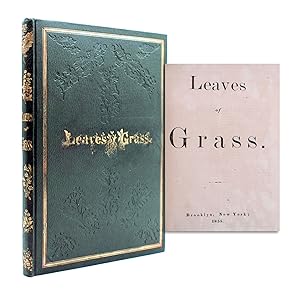
![Seller image for Leaves of Grass [with] Whitman s own copy of his 1860 portrait for sale by 19th Century Rare Book & Photograph Shop](https://pictures.abebooks.com/inventory/md/md31724312240.jpg)

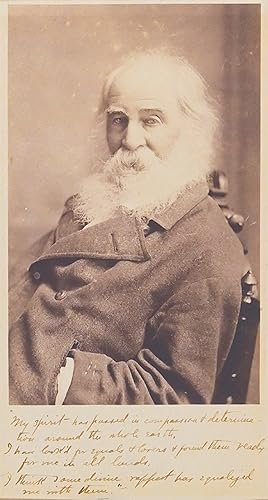
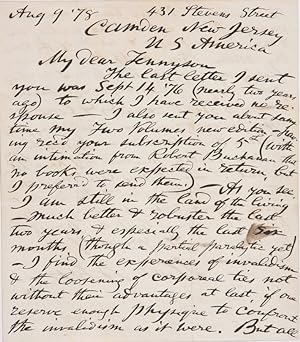
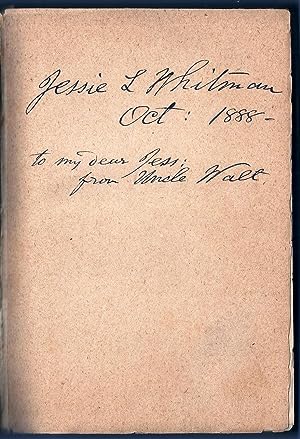
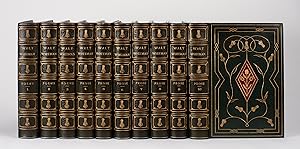
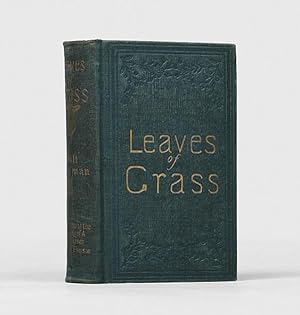
![Seller image for Autograph letter signed to his sister [together with] To the Sun-Set Breeze Original printer s proof, signed by Whitman. for sale by 19th Century Rare Book & Photograph Shop](https://pictures.abebooks.com/inventory/md/md31813060212.jpg)
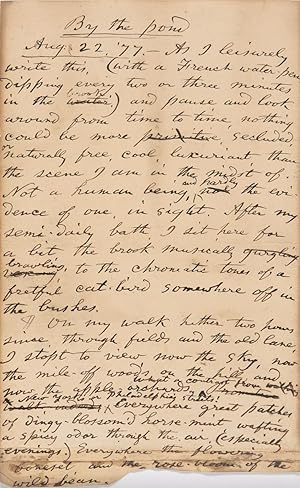

![Seller image for [Whitman, Walt- Very Fine Copy of the Exceedingly Scarce First Issue Drum-Taps, Presented by Whitman to a Boy Nextdoor, As Recorded by the Boy's Subsequent Presentation Inscription Years Later] Drum-Taps. First edition for sale by Nudelman Rare Books](https://pictures.abebooks.com/inventory/md/md30896069802.jpg)
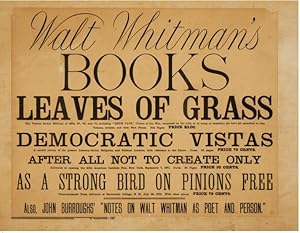

![Seller image for Complete Poems & Prose of Walt Whitman 1855. 1888 [Leaves of Grass] for sale by Manhattan Rare Book Company, ABAA, ILAB](https://pictures.abebooks.com/inventory/md/md30928934484.jpg)
![Seller image for Leaves of Grass. 3 Vols. (# 2 of 32 copies) WITH full page hand corrected - with 15 changes to the text -Manuscript Leaf from "Specimen Days & Collect," along with three additional volumes from The Complete Writings of Walt Whitman. Issued under the editorial supervision of his literary executors, Richard Maurice Bucke, Thomas B. Harned, and Horace L. Traubel; with additional bibliographical and critical material prepared by Oscar Lovell Triggs. Printed in 32 copies - this the true first and complete collection [6 of 10 Volumes] for sale by ERIC CHAIM KLINE, BOOKSELLER (ABAA ILAB)](https://pictures.abebooks.com/inventory/md/md30649452982.jpg)
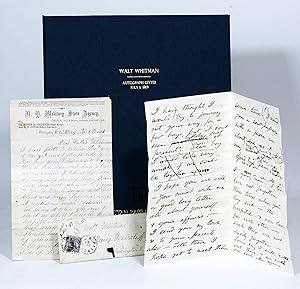
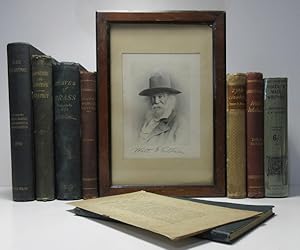

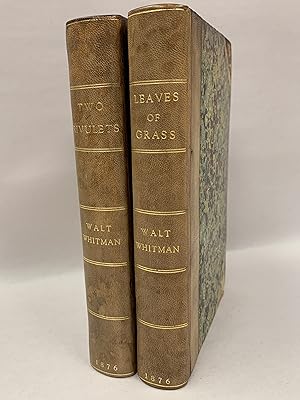
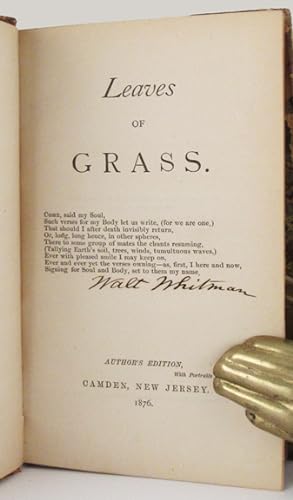
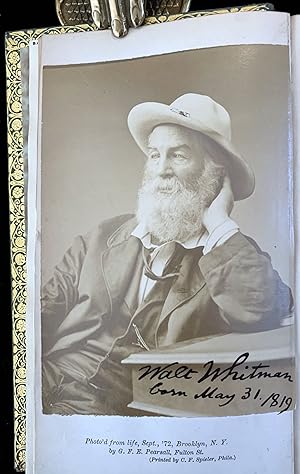
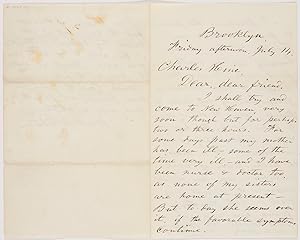
![Seller image for Leaves of Grass [with] Two Rivulets for sale by Cleveland Book Company, ABAA](https://pictures.abebooks.com/inventory/md/md31729558186.jpg)


